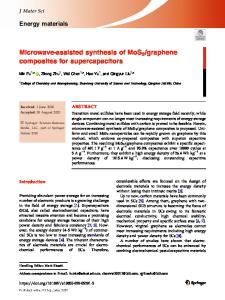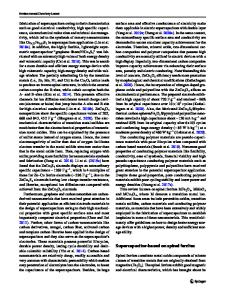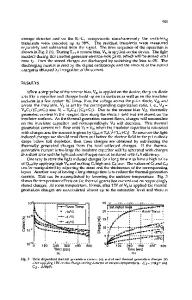Scrutinizing the charge storage mechanism in SrO based composites for asymmetric supercapacitors by diffusion-controlled
- PDF / 4,144,290 Bytes
- 13 Pages / 595.276 x 790.866 pts Page_size
- 32 Downloads / 343 Views
ORIGINAL ARTICLE
Scrutinizing the charge storage mechanism in SrO based composites for asymmetric supercapacitors by diffusion‑controlled process Muhammad Zahir Iqbal1 · Sana Zakar1 · Muhammad Tayyab1 · Syed Shabhi Haider1 · Meshal Alzaid2 · Amir Muhammad Afzal3 · Sikandar Aftab4 Received: 16 April 2020 / Accepted: 22 June 2020 © King Abdulaziz City for Science and Technology 2020
Abstract Optimization of suitable electrode material flashing high electrochemical performance is the main hindrance in energy storage applications. Metal oxide-based electrode materials are promising candidate which greatly promotes the sustainable development. Herein, strontium oxide (SrO) is synthesized from sonochemical method followed by calcination. Incorporating polyaniline (PANI) and graphene (Gr) intensify the materials performance. Three asymmetric devices are designed using SrO, its composites (SrO/PANI and SrO/PANI/Gr) and activated carbon (AC) as an electrode and electrolyte-soaked separators are sandwiched in solidly packed cell assembly. Electrochemical measurements are performed to scrutinize the inherent properties. After that, Dunn’s model is applied to evaluate the capacitive and diffusion-controlled contributions. The obtained result divulges that SrO/PANI/Gr//AC exhibits more diffusive-controlled contribution and reveals a battery type behavior due to the contribution of PANI in redox reactions. Thus, this work delivers a route to synthesize metal oxides-based composites and a systematic approach to analyze the charge storage mechanism in asymmetric supercapacitors. Keywords Asymmetric supercapacitors · Battery-grade materials · Composites · Capacitive insertion · Diffusion processes
Introduction Recent research is focused on energy storage devices due to increasing demands of high energy and power density with long life cycle and fast rechargeability (Goodenough 2012; Goodenough 2014; Dunn et al. 2011; Dai et al. 2012; Larcher and Tarascon 2015; Iqbal etal. 2019b, 2020b ). From electrochemical energy storage devices, high performance supercapacitor is significantly developed for futuristic emergence of clean energy storage systems. Wide spread * Muhammad Zahir Iqbal [email protected] 1
Nanotechnology Research Laboratory, Faculty of Engineering Sciences, GIK Institute of Engineering Sciences and Technology, Topi 23640, Khyber Pakhtunkhwa, Pakistan
2
Physics Department, College of Science, Jouf University, Sakaka P.O. Box 2014, Al‑Jouf, Saudi Arabia
3
Department of Electrical and Biological Physics, Kwangwoon University, Seoul 01897, Republic of Korea
4
Department of Engineering, Simon Faser University, Burnaby V5A 1S6, Canada
utilization of supercapacitor is because of its multiple applications including vehicles for accelerating and convalescence of brake energy due to having a high specific power (Kötz and Carlen 2000; Kalu et al. 2001; Thounthong et al. 2009; Vidyadharan et al. 2014; Iqbal etal. 2020d). Supercapacitors bridge the gap between batteries and conventional capacitors and on the
Data Loading...











